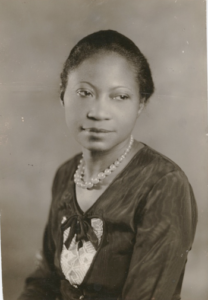
Augusta Savage
*This date celebrates the birth of Augusta Savage in 1892. She was a Black sculptor and educator who battled racism to secure a place for blacks in the art world.
From Green Cove Springs, Fla., Augusta Christine Savage's family moved to West Palm Beach about 1907, where she thrived academically, conducting art classes for a dollar a day while still a student. After failing to make a living by executing commissioned busts of Jacksonville's well-to-do Blacks, she moved to New York City to study art. In 1921, she enrolled at Cooper Union in the four-year sculpture course, but her instructors quickly waived her first two years in light of her talent.
In 1923, Savage became the focus of a racial scandal involving the French government and the American arts community. She was among some 100 young American women selected to attend a summer program at Fontainebleau, outside Paris, but her application was subsequently refused based on her race. Sculptor Hermon A. MacNeil was the only member of the committee to denounce the decision, and he invited Savage to study with him in an attempt to make amends.
Following this period, Savage worked in steam laundries to earn money to care for her family and save for European studies. Her plans were derailed, however, when her family suffered a series of tragedies. In the 1920s, she received a commission to sculpt a portrait bust of W.E.B. Du Bois, and then another of Black Nationalist Marcus Garvey; both pieces were hailed for their power and dynamism. Though Savage was finally able, with the assistance of W.E.B. Du Bois, to study at a Paris art academy in 1929-31, the Great Depression brought art sales to a virtual standstill. She turned to teaching art, founding her own arts and crafts school in New York City's Harlem in the early 1930s.
In the mid-1930s, she founded and became the first director of the Harlem Community Art Center, crucial in developing many young African American artists. During this period, too, she became the first Black elected to the National Association of Women Painters and Sculptors. Savage also fought successfully to include Black artists in Works Progress Administration projects. In the late 1930s, Savage opened a gallery specializing in art by blacks, but it did not survive long.
She apparently abandoned her art in the 1940s, isolating herself on a farm in Saugerties, N.Y. Many of Savage's sculptures were never cast in permanent materials and have been lost. Among the few extant pieces is the poignant Gamin 1929, a portrait bust of a street-wise boy. Augusta Savage died on March 26, 1962, in New York City.
Reference:
Black Women in America: An Historical Encyclopedia
Volumes 1 and 2, edited by Darlene Clark Hine
Copyright 1993, Carlson Publishing Inc., Brooklyn, New York
ISBN 0-926019-61-9